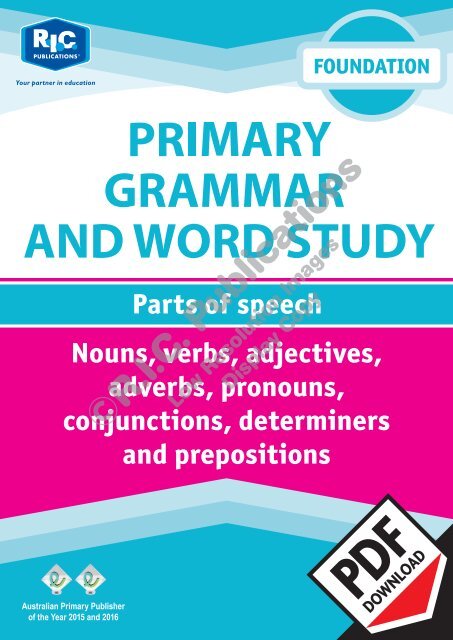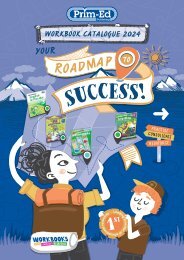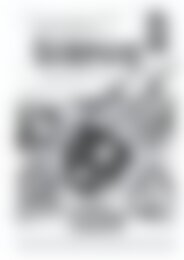RIC-20222 Primary Grammar and Word Study Foundation – Parts of Speech
You also want an ePaper? Increase the reach of your titles
YUMPU automatically turns print PDFs into web optimized ePapers that Google loves.
©R.I.C. Publications<br />
Low Resolution Images<br />
Display Copy
<strong>Primary</strong> grammar <strong>and</strong> word study (Book A)<br />
Published by R.I.C. Publications ® 2008<br />
Copyright © by R.I.C. Publications ® 2008<br />
This master may only be reproduced by the<br />
original purchaser for use with their class(es). The<br />
publisher prohibits the loaning or onselling <strong>of</strong> this<br />
master for the purposes <strong>of</strong> reproduction.<br />
<strong>RIC</strong><strong>–</strong><strong>20222</strong><br />
Copyright Notice<br />
Blackline masters or copy masters are published <strong>and</strong><br />
sold with a limited copyright. This copyright allows<br />
publishers to provide teachers <strong>and</strong> schools with a<br />
wide range <strong>of</strong> learning activities without copyright<br />
being breached. This limited copyright allows the<br />
purchaser to make sufficient copies for use within<br />
their own education institution. The copyright is not<br />
transferable, nor can it be onsold. Following these<br />
instructions is not essential but will ensure that you,<br />
as the purchaser, have evidence <strong>of</strong> legal ownership<br />
to the copyright if inspection occurs.<br />
For your added protection in the case <strong>of</strong> copyright<br />
inspection, please complete the form below. Retain<br />
this form, the complete original document <strong>and</strong> the<br />
invoice or receipt as pro<strong>of</strong> <strong>of</strong> purchase.<br />
Name <strong>of</strong> Purchaser:<br />
Date <strong>of</strong> Purchase:<br />
Supplier:<br />
School Order# (if applicable):<br />
Signature <strong>of</strong> Purchaser:<br />
©R.I.C. Publications<br />
Low Resolution Images<br />
Display Copy<br />
Internet websites<br />
In some cases, websites or specific URLs may be recommended. While these are checked <strong>and</strong> rechecked at the time <strong>of</strong> publication,<br />
the publisher has no control over any subsequent changes which may be made to webpages. It is strongly recommended that the class<br />
teacher checks all URLs before allowing students to access them.<br />
View all pages online<br />
PO Box 332 Greenwood Western Australia 6924<br />
Website: www.ricpublications.com.au<br />
Email: mail@ricgroup.com.au
<strong>Primary</strong> grammar <strong>and</strong><br />
word study <strong>–</strong> Book A<br />
Foreword<br />
<strong>Primary</strong> grammar <strong>and</strong> word study is a series <strong>of</strong> seven books designed<br />
to introduce students to parts <strong>of</strong> speech, ways to underst<strong>and</strong> <strong>and</strong> choose<br />
words, punctuation <strong>and</strong> figures <strong>of</strong> speech.<br />
Titles in this series:<br />
• <strong>Primary</strong> grammar <strong>and</strong> word study Book A (Ages 5<strong>–</strong> 6)<br />
• <strong>Primary</strong> grammar <strong>and</strong> word study Book B (Ages 6<strong>–</strong>7)<br />
• <strong>Primary</strong> grammar <strong>and</strong> word study Book C (Ages 7<strong>–</strong>8)<br />
• <strong>Primary</strong> grammar <strong>and</strong> word study Book D (Ages 8<strong>–</strong>9)<br />
• <strong>Primary</strong> grammar <strong>and</strong> word study Book E (Ages 9 <strong>–</strong>10)<br />
• <strong>Primary</strong> grammar <strong>and</strong> word study Book F (Ages 10<strong>–</strong>11)<br />
• <strong>Primary</strong> grammar <strong>and</strong> word study Book G (Ages 11<strong>–</strong>12)<br />
Teachers notes ..............................................iv <strong>–</strong> v<br />
English curriculum links ...................................... v<br />
Literacy character explanation ..................... vi <strong>–</strong> vii<br />
Checklists ................................................... viii <strong>–</strong> xi<br />
<strong>Parts</strong> <strong>of</strong> speech ............................................. 2<strong>–</strong>33<br />
Nouns ............................................................. 2<strong>–</strong>5<br />
Verbs ............................................................. 6<strong>–</strong>11<br />
Adjectives .................................................... 12<strong>–</strong>17<br />
Adverbs ....................................................... 18<strong>–</strong>21<br />
Pronouns ..................................................... 22<strong>–</strong>25<br />
Conjunctions ............................................... 26<strong>–</strong>27<br />
Determiners ................................................ 28<strong>–</strong>31<br />
Prepositions ................................................ 32<strong>–</strong>33<br />
Contents<br />
<strong>Word</strong>s that change .................................... 50<strong>–</strong>53<br />
Plurals .................................................... 50<strong>–</strong>53<br />
<strong>Word</strong>s <strong>and</strong> their meanings ........................ 54<strong>–</strong>57<br />
Synonyms ............................................... 54<strong>–</strong>55<br />
Antonyms ............................................... 56<strong>–</strong>57<br />
Confused words ........................................ 58<strong>–</strong>61<br />
Punctuation ................................................. 62<strong>–</strong>75<br />
©R.I.C. Publications<br />
Low Resolution Images<br />
Display Copy<br />
Full stops .................................................... 62<strong>–</strong>63<br />
Question marks ........................................... 64<strong>–</strong>65<br />
Exclamation marks ...................................... 66<strong>–</strong>67<br />
Capital letters .............................................. 68<strong>–</strong>71<br />
Commas ...................................................... 72<strong>–</strong>73<br />
Apostrophes ................................................ 74<strong>–</strong>75<br />
Underst<strong>and</strong>ing <strong>and</strong> choosing words .......... 34<strong>–</strong>61<br />
<strong>Word</strong>s that are similar .............................. 34<strong>–</strong>49<br />
Homographs ........................................... 34<strong>–</strong>35<br />
Homophones .......................................... 36<strong>–</strong>37<br />
<strong>Word</strong> groups ........................................... 38<strong>–</strong>49<br />
Figures <strong>of</strong> speech ........................................ 76<strong>–</strong>83<br />
Alliteration .................................................... 76<strong>–</strong>77<br />
Similes ......................................................... 78<strong>–</strong>79<br />
Onomatopoeia .............................................. 80<strong>–</strong>81<br />
Personification .............................................. 82<strong>–</strong>83<br />
R.I.C. Publications ® www.ricpublications.com.au iii<br />
<strong>Primary</strong> grammar <strong>and</strong> word study
<strong>Parts</strong> <strong>of</strong> speech checklist<br />
Name <strong>of</strong> student Nouns Verbs Adjectives Adverbs Pronouns Conjunctions Determiners Prepositions<br />
©R.I.C. Publications<br />
Low Resolution Images<br />
Display Copy<br />
<strong>Primary</strong> grammar <strong>and</strong> word study viii<br />
www.ricpublications.com.au R.I.C. Publications ®
<strong>Parts</strong> <strong>of</strong> speech<br />
Nouns<br />
Focus<br />
Common nouns<br />
Definitions<br />
• Nouns are words used to name people, places,<br />
things, feelings <strong>and</strong> ideas.<br />
• Common nouns name general, rather than<br />
particular, things that you can see <strong>and</strong> touch.<br />
Example:<br />
The farmer’s dirty feet left marks all over the<br />
floor.<br />
Explanation<br />
• The word ‘noun’ comes from the Latin ‘nomen’,<br />
which means ‘name’. Nouns are <strong>of</strong>ten called<br />
‘naming words’.<br />
• While most nouns can be categorised as either<br />
common or proper nouns, there are two further main<br />
categories; collective (e.g. swarm) <strong>and</strong> abstract<br />
(e.g. sorrow) nouns.<br />
• Some words used as nouns can also be verbs or<br />
adjectives, depending on the context in which they<br />
are used.<br />
Example:<br />
John decided to ring (verb) the jeweller about<br />
Suzie’s damaged ring (noun).<br />
• Common nouns are not capitalised unless they begin<br />
a sentence or start a title.<br />
Worksheet information<br />
• The depth <strong>of</strong> the introduction necessary for the<br />
development <strong>of</strong> an underst<strong>and</strong>ing <strong>of</strong> nouns will vary.<br />
Students must first underst<strong>and</strong> what ‘words’ are.<br />
They also need to be able to underst<strong>and</strong> the concept<br />
<strong>of</strong> people, places <strong>and</strong> things.<br />
• A suggested introduction is to prepare cutout<br />
pictures <strong>of</strong> people, places <strong>and</strong> things from<br />
magazines. Draw a table on the board with the<br />
headings: ‘people’, ‘places’ <strong>and</strong> ‘things’. Ask<br />
students to sort the pictures <strong>and</strong> classify them by<br />
sticking them on the board under the appropriate<br />
heading. Write the name (noun) for each picture<br />
next to it. Explain to the students that the words we<br />
use to name people, places <strong>and</strong> things are called<br />
‘nouns’.<br />
• Give each student a copy <strong>of</strong> the worksheet <strong>and</strong><br />
explain the tasks.<br />
In Question 1, students write three people, places<br />
<strong>and</strong> things from the picture.<br />
In Question 2, they make up a funny story or song<br />
using three nouns <strong>of</strong> their own which they have<br />
written on the page. Encourage students to write<br />
a common noun—e.g. boy, man, cowboy—rather<br />
than a proper noun. They can tell or sing their funny<br />
stories or songs to each other.<br />
Ideas for further practice<br />
©R.I.C. Publications<br />
Low Resolution Images<br />
Display Copy<br />
• Play ‘I-spy’ with the students to practise naming the<br />
‘things’ in the classroom.<br />
• Read simple stories with the students. Ask them to<br />
recall people, places <strong>and</strong> things from the story <strong>and</strong><br />
list these under the appropriate headings.<br />
• Students could go on a ‘noun hunt’ in the classroom<br />
or school grounds, finding as many nouns as they<br />
can.<br />
• is an interactive game where<br />
students practise identifying nouns.<br />
Answers<br />
1. places: park, school, shop<br />
people: boy, girl, woman, baby<br />
things: swing, ball, tree, flower, bird, grass, bench,<br />
bin<br />
2. Teacher check<br />
<strong>Primary</strong> grammar <strong>and</strong> word study 2<br />
www.ricpublications.com.au R.I.C. Publications ®
Nouns<br />
Nouns are naming words for people,<br />
places <strong>and</strong> things.<br />
shop<br />
bin<br />
1. From the picture, write three:<br />
places<br />
people<br />
things.<br />
swing<br />
flower<br />
school<br />
girl<br />
grass<br />
2. Write one place, one<br />
person <strong>and</strong> one thing.<br />
Use these nouns<br />
to make up a funny<br />
story or song to tell a<br />
partner.<br />
ball<br />
bench<br />
boy<br />
woman<br />
baby<br />
boy<br />
©R.I.C. Publications<br />
Low Resolution Images<br />
Display Copy<br />
bird<br />
park<br />
tree<br />
R.I.C. Publications ® www.ricpublications.com.au 3<br />
<strong>Primary</strong> grammar <strong>and</strong> word study
<strong>Parts</strong> <strong>of</strong> speech<br />
Nouns<br />
Focus<br />
Proper nouns<br />
Definition<br />
• Proper nouns are used to name specific people,<br />
places or things <strong>and</strong> begin with capital letters.<br />
Example:<br />
Jarrad was due to fly in from London on Friday.<br />
Explanation<br />
• Nouns can provide us information about who, what<br />
<strong>and</strong> where. Proper nouns are also called proper<br />
names <strong>and</strong> name a specific or particular person,<br />
place, animal or thing. Proper nouns are almost<br />
always capitalised but not all capitalised words are<br />
proper nouns.<br />
• Trademarks are also capitalised.<br />
• Some words that would appear to need<br />
capitalisation, such as the names <strong>of</strong> the seasons<br />
(winter, summer, spring <strong>and</strong> autumn), are no longer<br />
capitalised because, through long usage, they have<br />
come to be considered common nouns. Cardinal<br />
directions (north, south, east <strong>and</strong> west); words for<br />
relatives (mum, aunty)—unless it is used as part<br />
<strong>of</strong> the name, such as Aunty Maude; <strong>and</strong> names <strong>of</strong><br />
subject areas (maths, science) are also no longer<br />
considered proper nouns.<br />
Worksheet information<br />
• Review what a noun is with the students. Give each<br />
student a copy <strong>of</strong> the worksheet <strong>and</strong> read the text<br />
defining proper nouns. Explain that these are nouns<br />
that give special people, places or things their own<br />
name. Read the sentences about the boy <strong>and</strong> his cat.<br />
Ask students to notice the words in bold; they have<br />
capital letters <strong>and</strong> are the name <strong>of</strong> the boy, the name<br />
<strong>of</strong> his cat, <strong>and</strong> the name <strong>of</strong> the city in which they<br />
live. They could then identify the common nouns<br />
(boy, cat, city).<br />
• Students then practise writing proper nouns by<br />
providing information about themselves. They<br />
practise identifying proper nouns by colouring the<br />
pictures which have proper nouns written beneath<br />
them.<br />
Ideas for further practice<br />
• Students can find nouns in sentences online at<br />
<br />
• Students can create riddles where the answer is a<br />
proper noun. Partners try to guess the answers.<br />
• Proper noun hunt: Students set <strong>of</strong>f to find <strong>and</strong> write<br />
as many proper nouns from the classroom as they<br />
can in five minutes. Turn the students findings into a<br />
class book <strong>of</strong> proper nouns.<br />
Answers<br />
1. Teacher check<br />
2. The pictures <strong>of</strong> Jess Gresham, Mrs Deering, Leroy<br />
<strong>and</strong> JoJo’s Cafe should be coloured.<br />
©R.I.C. Publications<br />
Low Resolution Images<br />
Display Copy<br />
<strong>Primary</strong> grammar <strong>and</strong> word study 4<br />
www.ricpublications.com.au R.I.C. Publications ®
Proper nouns<br />
Some nouns are the special names for a person,<br />
place or thing. They are called proper nouns <strong>and</strong><br />
start with capital letters.<br />
My name is Jacob. I’m a boy.<br />
This is Puff. She is my cat.<br />
We live in Oxford. It’s a big city.<br />
1. What about you?<br />
My name is .<br />
I live in .<br />
I have/want a pet named .<br />
My friends are .<br />
2. Colour the pictures <strong>of</strong> proper nouns.<br />
©R.I.C. Publications<br />
Low Resolution Images<br />
Display Copy<br />
kids penguin Jess Gresham<br />
Mrs Deering Leroy Jojo’s Cafe<br />
R.I.C. Publications ® www.ricpublications.com.au 5<br />
<strong>Primary</strong> grammar <strong>and</strong> word study
<strong>Parts</strong> <strong>of</strong> speech<br />
Verbs<br />
Focus<br />
Finite verbs<br />
Definition<br />
• Verbs or ‘doing’ words show actions or states <strong>of</strong><br />
being or having.<br />
Example:<br />
The boy ran to the gate.<br />
Humpty Dumpty sat on a wall.<br />
The cow jumped over the moon.<br />
‘Ran’, ‘sat’ <strong>and</strong> ‘jumped’ are verbs which tell about<br />
an action.<br />
Example:<br />
He has a cold <strong>and</strong> he is sick.<br />
‘Has’ is a form <strong>of</strong> the verb ‘to have’ <strong>and</strong> ‘is’ is a form<br />
<strong>of</strong> the verb ‘to be’.<br />
Explanation<br />
• Finite verbs change in form to match their subject<br />
or to indicate tense.<br />
Example:<br />
runs, run, ran<br />
• Non-finite verbs do not change.<br />
Example:<br />
present participles <strong>–</strong> working<br />
past participles <strong>–</strong> worked<br />
infinitives <strong>–</strong> to work<br />
• Verbs must have someone doing the action (the<br />
subject). For the examples in the Definition section<br />
above, the actions are done by ‘the boy’, ‘Humpty<br />
Dumpty’ <strong>and</strong> ‘the cow’.<br />
• Most verbs describe actions, but verbs also show<br />
states <strong>of</strong> ‘being’ or ‘having’. The verbs ‘to have’ <strong>and</strong><br />
‘to be’ have many forms which change with the<br />
subject <strong>and</strong> the tense.<br />
Example:<br />
to have <strong>–</strong> has, have, had<br />
to be <strong>–</strong> am, is, are, was, were<br />
• Every sentence must contain a verb.<br />
Worksheet information<br />
• Read the rhyme with the students, emphasising the<br />
verbs (doing words).<br />
• Read the explanation about verbs to the students<br />
while they follow the words.<br />
• Ask the questions: ‘What am I (row 1) doing?, What<br />
are the bells doing?, ‘What am I (row 3) doing?,<br />
‘What are the elephants doing?’ etc.<br />
• Students use coloured pencils to circle the verbs in<br />
the rhyme which were emphasised while reading.<br />
Repeat the reading if necessary.<br />
• Read the instruction for Question 3, then students<br />
can match the pictures to the most appropriate verb.<br />
• As a class, read the picture<strong>–</strong>sentences together;<br />
e.g. dogs dig, cats lick etc.<br />
Ideas for further practice<br />
• Recite popular nursery rhymes with the students<br />
<strong>and</strong> whenever a verb (doing word) appears, ask the<br />
students to shout the word loudly. Give examples<br />
first.<br />
• Make up simple sentences with missing verbs to<br />
complete orally with the students.<br />
Example:<br />
The clown<br />
the car.<br />
©R.I.C. Publications<br />
Low Resolution Images<br />
Display Copy<br />
• Play action games such as ‘What can you do<br />
Punchinello, funny fellow?’ where students must<br />
make up actions for Punchinello to demonstrate for<br />
others to copy.<br />
Answers<br />
1.<strong>–</strong>2. Teacher check<br />
3. dogs dig, cats lick, ducks quack, rockets zoom<br />
<strong>Primary</strong> grammar <strong>and</strong> word study 6<br />
www.ricpublications.com.au R.I.C. Publications ®
Verbs are doing words.<br />
1. Read the rhyme.<br />
Verbs<br />
I sing.<br />
Bells ring.<br />
I jump.<br />
Elephants thump.<br />
I cry.<br />
Birds fly.<br />
I sleep.<br />
Mice creep.<br />
Verbs can tell what people or things are doing.<br />
A sentence must have a ‘doing’ word.<br />
2. Circle the doing words in the rhyme.<br />
3. Draw a line to match the doing word to the correct picture.<br />
dig<br />
©R.I.C. Publications<br />
Low Resolution Images<br />
Display Copy<br />
lick<br />
zoom<br />
quack<br />
R.I.C. Publications ® www.ricpublications.com.au 7<br />
<strong>Primary</strong> grammar <strong>and</strong> word study
<strong>Parts</strong> <strong>of</strong> speech<br />
Verbs<br />
Focus<br />
Comm<strong>and</strong> verbs (imperatives)<br />
Definition<br />
• Comm<strong>and</strong> verbs are used to order, comm<strong>and</strong> or<br />
instruct.<br />
Example:<br />
Clean your teeth.<br />
Mix the cake batter.<br />
Explanation<br />
• Verbs can describe actions (doing words) <strong>and</strong> must<br />
have someone ‘doing’ the action (the subject). Refer<br />
to pages 6 <strong>and</strong> 7.<br />
• Most verbs describe actions but verbs can also show<br />
states <strong>of</strong> ‘being’ or ‘having’.<br />
Example:<br />
to be <strong>–</strong> am, is, are, was, were<br />
to have <strong>–</strong> has, have, had<br />
• Every sentence must contain a verb.<br />
• Comm<strong>and</strong> verbs are commonly used when writing<br />
procedures <strong>and</strong> are usually the first word in the<br />
sentence.<br />
Worksheet information<br />
• Play a game such as ‘Simon says’ where students<br />
must follow the comm<strong>and</strong>s given.<br />
• Read the heading <strong>and</strong> explain what ‘comm<strong>and</strong>’<br />
means. Remind the students that a verb is a ‘doing’<br />
or action word. A comm<strong>and</strong> verb is a word that<br />
comm<strong>and</strong>s or orders someone to do something.<br />
Do not be overly concerned if the students do not<br />
remember the term.<br />
• Read the text with the students <strong>and</strong> say the words<br />
for the pictures in the procedure. Emphasise the<br />
comm<strong>and</strong> verbs when reading the text.<br />
• Ask students to identify the comm<strong>and</strong> verbs <strong>and</strong><br />
write them to complete Question 2. Beginning<br />
sounds have been given to assist students with<br />
finding them in the text. Tell the students that all<br />
the comm<strong>and</strong> verbs in this text have a capital letter<br />
because they all start sentences.<br />
• Read the instructions for Question 3. Tell the<br />
students that these are comm<strong>and</strong> verbs. Discuss<br />
a character from a well-known nursery rhyme<br />
or fairytale who may have said ‘Help!’ or ‘Stop!’<br />
Students could also relate a situation where the<br />
verbs were spoken; for example: when someone<br />
is in deep water <strong>and</strong> cannot swim well or when a<br />
child runs near the road <strong>and</strong> Mum yells at him/her.<br />
Students should draw simple pictures to match the<br />
spoken comm<strong>and</strong> verbs.<br />
• Select a few students to talk about their pictures.<br />
Ask them to tell who is saying the comm<strong>and</strong> verb<br />
<strong>and</strong> who they may be talking to.<br />
Ideas for further practice<br />
• Learn <strong>and</strong> say rhymes which contain comm<strong>and</strong><br />
verbs such as ‘“Stop”, said the red light; “Go”, says<br />
the green …’<br />
• Identify comm<strong>and</strong> verbs in familiar fairytales <strong>and</strong><br />
traditional stories such as ‘Run, run as fast as you<br />
can. You can’t catch me, I’m the gingerbread man’.<br />
• Play games in the playground where students must<br />
listen to an order or comm<strong>and</strong> <strong>and</strong> carry out the<br />
action; for example: ‘Run to the tree <strong>and</strong> skip back’.<br />
Emphasise the comm<strong>and</strong> verbs when speaking.<br />
©R.I.C. Publications<br />
Low Resolution Images<br />
Display Copy<br />
Answers<br />
1. Teacher check<br />
2. Mix, Melt, Add, Tip, Cook, Lick<br />
3. Teacher check<br />
<strong>Primary</strong> grammar <strong>and</strong> word study 8<br />
www.ricpublications.com.au R.I.C. Publications ®
1. Read the procedure.<br />
Comm<strong>and</strong> verbs<br />
Mix , , <strong>and</strong> in bowl.<br />
Melt in .<br />
Add , <strong>and</strong> .<br />
Add butter mixture to .<br />
Mix all together.<br />
Tip into .<br />
Cook in .<br />
Lick the .<br />
Comm<strong>and</strong> verbs give orders.<br />
2. Write six comm<strong>and</strong> verbs from the procedure.<br />
M M A<br />
©R.I.C. Publications<br />
Low Resolution Images<br />
Display Copy<br />
T C L<br />
3. Draw a picture to tell what is happening.<br />
Help!<br />
Stop!<br />
R.I.C. Publications ® www.ricpublications.com.au 9<br />
<strong>Primary</strong> grammar <strong>and</strong> word study
<strong>Parts</strong> <strong>of</strong> speech<br />
Verbs<br />
Focus<br />
Past, present <strong>and</strong> future tense (with auxiliary verbs)<br />
Definitions<br />
• Verb tense shows whether the action <strong>of</strong> the verb<br />
occurs in the present, the past or the future.<br />
• Auxiliary verbs are small verbs, <strong>of</strong>ten a form <strong>of</strong> the<br />
verb ‘to be’ or ‘to have’, that combine with another<br />
verb to form a compound verb.<br />
Explanation<br />
• There are three basic verb tenses—past, present<br />
<strong>and</strong> future. These tenses are <strong>of</strong>ten formed using an<br />
auxiliary or helping verb such as ‘is’, ‘can’, ‘had’<br />
<strong>and</strong> ‘will’.<br />
Example:<br />
I jump. She jumps. (present tense)<br />
I jumped. (past tense)<br />
I have jumped. (past tense with an auxiliary verb<br />
<strong>–</strong> ‘have’)<br />
I will jump. (future tense with an auxiliary verb <strong>–</strong><br />
‘will’)<br />
• Verbs must have someone ‘doing’ the action. For the<br />
examples above, the actions are done by ‘I’.<br />
• Most verbs describe actions, but verbs also show<br />
states <strong>of</strong> ‘being’ or ‘having’.<br />
Example:<br />
to be <strong>–</strong> am, is, are, was, were<br />
to have <strong>–</strong> has, have, had<br />
• Every sentence must contain a verb.<br />
• Some verb tense forms are regular but many are<br />
irregular.<br />
Example:<br />
‘I buy my lunch today’ (present tense) becomes<br />
‘I bought my lunch yesterday’ (past tense).<br />
Worksheet information<br />
• As the concept <strong>of</strong> verb tense is very difficult for<br />
this age group, particularly in reference to auxiliary<br />
verbs, the intention is ONLY to expose the students<br />
to different tenses while reading a short text.<br />
However, young students will be very familiar with<br />
sentences which include ‘I am …’ <strong>and</strong> ‘I will …’<br />
when writing or reading.<br />
• Read the text with the students, encouraging them<br />
to say any words they recognise. Emphasise the<br />
verbs when reading aloud to make the students<br />
more aware <strong>of</strong> them.<br />
• Discuss <strong>and</strong> identify which words are verbs or ‘doing<br />
words’, while the students circle them. Ensure that<br />
the students circle ‘will be’ (two parts). Tell them it is<br />
a ‘tricky’ verb that has two parts.<br />
• Once the verbs are circled, the students can copy<br />
the verbs into the correct boxes.<br />
NOTE: In Question 3, the future tense verbs, ‘will be’,<br />
‘am’ <strong>and</strong> ‘went’ have been given. Students are only<br />
required to find <strong>and</strong> write the more obvious verbs<br />
from the text.<br />
Ideas for further practice<br />
• With the students sitting in a circle, select a few<br />
students to tell a sentence about something they<br />
did yesterday. Write the verbs on the board as each<br />
student relates his/her sentence. Repeat with other<br />
students, relating what they are doing today <strong>and</strong><br />
what they will be doing tomorrow. Used different<br />
coloured chalk or markers for past, present <strong>and</strong><br />
future verbs <strong>and</strong> compare them. Note any which<br />
have two parts.<br />
• Ask students to write their own three sentences<br />
about yesterday, today <strong>and</strong> tomorrow <strong>and</strong> draw a<br />
picture to illustrate each. Students should be asked<br />
to identify the verbs.<br />
• Listen to stories about children who have grown <strong>and</strong><br />
changed <strong>and</strong> learnt to do new things.<br />
©R.I.C. Publications<br />
Low Resolution Images<br />
Display Copy<br />
Answers<br />
1.<strong>–</strong>2. Teacher check<br />
3. Yesterday <strong>–</strong> went, played, climbed, zoomed<br />
Today <strong>–</strong> am, read, write, count, learn<br />
Tomorrow <strong>–</strong> will be<br />
<strong>Primary</strong> grammar <strong>and</strong> word study 10<br />
www.ricpublications.com.au R.I.C. Publications ®
Yesterday, today, tomorrow<br />
1. Read the text.<br />
Verbs are doing words.<br />
Yesterday, I went to the park.<br />
I played on the swings.<br />
I climbed up the ladder <strong>and</strong> zoomed down the<br />
slide.<br />
Today, I am at school.<br />
I read my books. I write my name <strong>and</strong> a story.<br />
I count to 20 <strong>and</strong> learn my shapes.<br />
Tomorrow, I will be a very smart sportsperson.<br />
2. Circle all the ‘doing’ words in the text.<br />
3. Copy the ‘doing words’ in the correct boxes.<br />
Yesterday<br />
I went. I pl .<br />
I cl . I z .<br />
Today<br />
I am. I r .<br />
I w . I c .<br />
I l .<br />
I w<br />
©R.I.C. Publications<br />
Low Resolution Images<br />
Display Copy<br />
Tomorrow<br />
R.I.C. Publications ® www.ricpublications.com.au 11<br />
<strong>Primary</strong> grammar <strong>and</strong> word study
<strong>Parts</strong> <strong>of</strong> speech<br />
Adjectives<br />
Focus<br />
Common adjectives<br />
Definition<br />
• An adjective is a describing word. It adds meaning<br />
to or changes the meaning <strong>of</strong> a noun or a pronoun.<br />
Example:<br />
These are shady trees. (describes the noun, ‘trees’)<br />
The pillow is s<strong>of</strong>t. (describes the noun, ‘pillow’)<br />
Note: The adjective does not always come before the<br />
noun:<br />
She is quiet. (describes the pronoun, ‘she’)<br />
Explanation<br />
• The use <strong>of</strong> suitable adjectives not only makes<br />
written or spoken language more interesting, it gives<br />
the reader or listener a clearer underst<strong>and</strong>ing.<br />
Worksheet information<br />
• The pictures on page 13 have descriptions<br />
underneath with missing adjectives. Explain to the<br />
students that the missing words are at the bottom <strong>of</strong><br />
the page. Discuss the pictures <strong>and</strong> descriptions with<br />
the students <strong>and</strong> read the words at the bottom. Ask<br />
them to suggest which would be the best word to<br />
cut out <strong>and</strong> glue under each picture.<br />
• Depending on the ability <strong>of</strong> your students, they may<br />
like to know these words are ‘describing’ words or<br />
‘adjectives’, which help to make our writing more<br />
interesting.<br />
Ideas for further practice<br />
• Present the worksheet on an overhead projector,<br />
but this time without the words at the bottom.<br />
Ask students to think <strong>of</strong> other words that could be<br />
written in the space under each picture. Alternatively,<br />
students could add another adjective before or after<br />
the one given; e.g. pretty, pink flower.<br />
• Students form circles <strong>of</strong> five or six. One student<br />
chooses an object from a selection that has been<br />
placed in the middle <strong>of</strong> the circle. He or she names<br />
the object <strong>and</strong> then thinks <strong>of</strong> a word to describe it,<br />
saying the word (adjective) out loud; e.g. a ball, a<br />
round ball.<br />
The object is passed to the next student, who then<br />
thinks <strong>of</strong> another adjective; e.g. a white ball.<br />
This continues until each student has had a turn.<br />
Other students can suggest an adjective if one<br />
student is having difficulty. The game continues with<br />
another object in the pile <strong>and</strong> so on.<br />
Answers<br />
1. a funny clown, a wet day, a hot drink, a pretty<br />
flower, a tall tree, a sad baby<br />
©R.I.C. Publications<br />
Low Resolution Images<br />
Display Copy<br />
<strong>Primary</strong> grammar <strong>and</strong> word study 12<br />
www.ricpublications.com.au R.I.C. Publications ®
Describing words <strong>–</strong> 1<br />
An adjective is a describing word.<br />
Cut out each describing word below. Glue it in the<br />
box under the correct picture.<br />
a clown a day<br />
a drink a flower<br />
©R.I.C. Publications<br />
Low Resolution Images<br />
Display Copy<br />
a tree a baby<br />
wet pretty hot<br />
tall sad funny<br />
R.I.C. Publications ® www.ricpublications.com.au 13<br />
<strong>Primary</strong> grammar <strong>and</strong> word study
<strong>Parts</strong> <strong>of</strong> speech<br />
Adjectives<br />
Focus<br />
Common adjectives<br />
Definition<br />
• An adjective is a describing word. It adds meaning<br />
to or changes the meaning <strong>of</strong> a noun or a pronoun.<br />
Example:<br />
Avoid busy roads. (describes the noun, ‘roads’)<br />
The kitten is cuddly. (describes the noun, ‘kitten’)<br />
Note: The adjective does not always come before the<br />
noun.<br />
He is tall. (describes the pronoun, ‘he’)<br />
Explanation<br />
• The use <strong>of</strong> suitable adjectives not only makes<br />
written or spoken language more interesting, it gives<br />
the reader or listener a clearer underst<strong>and</strong>ing.<br />
Worksheet information<br />
• Revise describing words by showing students<br />
various objects from the classroom or pictures <strong>of</strong><br />
objects. Ask them to suggest words which tell about<br />
or describe each. List them on the board or chart<br />
next to the object/picture.<br />
• Read the phrases on the worksheet, emphasising<br />
the describing words. Explain how their picture<br />
must match what the words say; e.g. It wouldn’t be<br />
raining in the hot, sunny day picture <strong>and</strong> any person<br />
in their picture shouldn’t have a coat on.<br />
After discussion, students draw <strong>and</strong> colour their<br />
pictures <strong>and</strong> share them in a group or with the class.<br />
Ideas for further practice<br />
• On a separate sheet <strong>of</strong> paper, students make up<br />
their own phrase(s) with two adjectives describing a<br />
noun. Display students’ work.<br />
• Provide students with a set <strong>of</strong> cards with nouns<br />
<strong>and</strong> a set <strong>of</strong> cards with words that can be used<br />
as adjectives. Place each face down or put in a<br />
container. Students take out one noun card <strong>and</strong> two<br />
adjective cards. They order the words <strong>and</strong> draw<br />
what they read. Some, <strong>of</strong> course, will be amusing!<br />
For example, the cards might read ‘hairy, red car’.<br />
Answers<br />
Teacher check<br />
©R.I.C. Publications<br />
Low Resolution Images<br />
Display Copy<br />
<strong>Primary</strong> grammar <strong>and</strong> word study 14<br />
www.ricpublications.com.au R.I.C. Publications ®
Describing words <strong>–</strong> 2<br />
An adjective is a describing word.<br />
1. Read the words.<br />
2. Draw <strong>and</strong> colour each picture in the box.<br />
(One has been drawn for you to colour.)<br />
a small, green frog<br />
a hot, sunny day<br />
©R.I.C. Publications<br />
Low Resolution Images<br />
Display Copy<br />
a little, grey<br />
mouse<br />
a fluffy, yellow chick<br />
a tall, thin man<br />
a long, curly worm<br />
R.I.C. Publications ® www.ricpublications.com.au 15<br />
<strong>Primary</strong> grammar <strong>and</strong> word study
<strong>Parts</strong> <strong>of</strong> speech<br />
Adjectives<br />
Focus<br />
Comparative <strong>and</strong> superlative adjectives<br />
Definitions<br />
• Comparative adjectives are used to compare two<br />
things, usually by adding the suffix ‘er’.<br />
Example:<br />
high, higher<br />
• Superlative adjectives are used to compare more<br />
than two things, usually by adding the suffix ‘est’.<br />
Example:<br />
s<strong>of</strong>t, s<strong>of</strong>test<br />
Explanation<br />
• If the adjective has two or more syllables, ‘more’ or<br />
‘most’ is usually added before the adjective.<br />
Example:<br />
comfortable, more comfortable, most comfortable.<br />
• But if an adjective <strong>of</strong> two or more syllables ends in<br />
‘y’, ‘er’ or ‘est’ is usually used.<br />
Example:<br />
dirty <strong>–</strong> dirtier <strong>–</strong> dirtiest<br />
• Some comparative <strong>and</strong> superlative adjectives are<br />
irregular.<br />
Example:<br />
bad <strong>–</strong> worse <strong>–</strong> worst<br />
good <strong>–</strong> better <strong>–</strong> best<br />
Worksheet information<br />
• The words used for comparison on page 17 only<br />
include simple words requiring ‘er’ or ‘est’. Use<br />
the pictures at the top <strong>of</strong> the page to introduce the<br />
concept. Students can then draw animals in the<br />
boxes to show ‘big’, ‘bigger’ <strong>and</strong> ‘biggest’ for<br />
Activity 2.<br />
• The story in Activity 3 will help to reinforce the<br />
concept in context. Read it with the students, asking<br />
them to add the missing correct word at the bottom<br />
<strong>of</strong> the page.<br />
Ideas for further practice<br />
• Ask students to find things in the classroom that<br />
have specific qualities.<br />
Example:<br />
narrow/narrower/narrowest<br />
tall/taller/tallest<br />
hard/harder/hardest<br />
• Some comparative <strong>and</strong> superlative adjectives are<br />
irregular.<br />
Example:<br />
good/better/best<br />
Students at this age may say ‘gooder’ instead <strong>of</strong><br />
‘better’. Provide opportunities for oral practice. For<br />
example, the teacher purposely says a work sample<br />
is good <strong>and</strong> another is ‘gooder’ or ‘goodest’, <strong>and</strong><br />
asks students what she/he should have said.<br />
Answers<br />
1.<strong>–</strong>2. Teacher check<br />
3. silly, redder, silliest<br />
©R.I.C. Publications<br />
Low Resolution Images<br />
Display Copy<br />
<strong>Primary</strong> grammar <strong>and</strong> word study 16<br />
www.ricpublications.com.au R.I.C. Publications ®
Comparing things<br />
1. Read what each animal is saying in the pictures.<br />
I am small. I am smaller. I am the smallest.<br />
When we compare two or more things,<br />
we can add er or est to a word.<br />
2. Draw pictures to show a big animal, a bigger animal <strong>and</strong> an<br />
animal that is the biggest.<br />
I am big. I am bigger. I am the biggest.<br />
3. Fill in the missing words to finish the story.<br />
We saw three silly clowns with red noses.<br />
First, the clown with a red nose was .<br />
He fell <strong>of</strong>f his bike.<br />
©R.I.C. Publications<br />
Low Resolution Images<br />
Display Copy<br />
Then, the clown with a<br />
nose<br />
was sillier. He tripped over his shoe.<br />
But the clown with the reddest nose<br />
was the<br />
. He got a<br />
custard pie in his face!<br />
silliest silly redder<br />
R.I.C. Publications ® www.ricpublications.com.au 17<br />
<strong>Primary</strong> grammar <strong>and</strong> word study
<strong>Parts</strong> <strong>of</strong> speech<br />
Adverbs<br />
Focus<br />
Common adverbs <strong>of</strong> manner<br />
Definition<br />
• An adverb is a word that adds information, usually<br />
to a verb <strong>and</strong> can tell about how (manner), when<br />
(time) or where (place) something happens.<br />
Example:<br />
The cows waited patiently.<br />
Note: Adverbs can modify (add information to) any<br />
words that are not nouns or pronouns. (These are<br />
modified by adjectives.)<br />
Explanation<br />
• Adverbs clarify meaning by telling more about the<br />
action, allowing for greater precision <strong>and</strong> adding<br />
interest to writing.<br />
• The words in italics in the story are all adverbs<br />
<strong>of</strong> manner. They all modify a verb, telling how it<br />
happens.<br />
• Some teachers may prefer to just focus on the<br />
concept <strong>of</strong> words telling how something happens,<br />
while others may like to also teach the term<br />
‘adverb’. Many children enjoy the fact that they can<br />
remember, underst<strong>and</strong> <strong>and</strong> use this term.<br />
Worksheet information<br />
• Introduce the worksheet by reading the story to the<br />
class, acting each <strong>of</strong> the verbs as described by the<br />
adverb; for example: roaring (verb) loudly (adverb).<br />
This will help any students who are unsure <strong>of</strong> the<br />
vocabulary used.<br />
• Read the story again, choosing particular students to<br />
show, for example, what Jack did <strong>and</strong> how he did it.<br />
(Jack jumped on the bus happily.)<br />
• The students can then be placed in small groups <strong>of</strong>:<br />
lions, elephants, birds, giraffes, the Jacks holding<br />
the rabbit, <strong>and</strong> the Jacks leaving. Each group should<br />
discuss what they are doing (the verb) <strong>and</strong> how they<br />
are doing it (the adverb) <strong>and</strong> practise it.<br />
• Read the story again <strong>and</strong> have the groups dramatise<br />
their parts as it is read.<br />
• Students can complete Question 1 by showing how<br />
the action happened, saying the adverb or copying<br />
the adverb from the text. (The adverbs are all in<br />
italics to facilitate this task.) Some students may,<br />
however, choose to do all three.<br />
• As preparation for completing Question 2, ask<br />
students from the different groups the questions:<br />
Who are you?<br />
What are you doing? (verb)<br />
How are you doing it? (adverb)<br />
How do you move? (adverb)<br />
• Question 2 should be modelled to the class before<br />
students work with a partner; for example: ‘I am a<br />
crocodile; I am sleeping; I am sleeping peacefully;<br />
I move silently’. It may be helpful to have one<br />
student ask the other questions as a prompt.<br />
Ideas for further practice<br />
• Students take turns to mime an action, then ask<br />
others to identify what they are doing <strong>and</strong> to suggest<br />
adverbs to say how they were doing this action;<br />
for example: ‘You were playing a guitar beautifully/<br />
quickly/happily/s<strong>of</strong>tly’.<br />
©R.I.C. Publications<br />
Low Resolution Images<br />
Display Copy<br />
Answers<br />
1. (a) loudly (b) quietly<br />
(c) gracefully (d) gently<br />
2. Teacher check<br />
<strong>Primary</strong> grammar <strong>and</strong> word study 18<br />
www.ricpublications.com.au R.I.C. Publications ®
How things happen <strong>–</strong> 1<br />
Jack listened to the lions roaring loudly.<br />
He listened to the elephants walking<br />
quietly.<br />
He saw the birds eating greedily.<br />
He saw the crocodiles sleeping peacefully.<br />
He saw the giraffes st<strong>and</strong>ing gracefully.<br />
He held the rabbits carefully <strong>and</strong> patted<br />
them gently.<br />
He left the zoo sadly. He climbed slowly on to the bus <strong>and</strong><br />
went back to school.<br />
<strong>Word</strong>s that tell how things happen are<br />
called adverbs.<br />
1. Show, tell or write your answers.<br />
(a) How did the lions roar?<br />
©R.I.C. Publications<br />
Low Resolution Images<br />
Display Copy<br />
(b) How did the elephants walk?<br />
(c) How did the giraffes st<strong>and</strong>?<br />
(d) How did Jack pat the rabbits?<br />
2. Draw a picture <strong>of</strong> one <strong>of</strong> the zoo animals on the back <strong>of</strong> this<br />
sheet. Tell a friend:<br />
(a) what animal it is<br />
(c) how it is doing it<br />
(b) what it is doing<br />
(d) how it moves.<br />
R.I.C. Publications ® www.ricpublications.com.au 19<br />
<strong>Primary</strong> grammar <strong>and</strong> word study
<strong>Parts</strong> <strong>of</strong> speech<br />
Adverbs<br />
Focus<br />
Common adverbs <strong>of</strong> manner<br />
Definition<br />
• An adverb is a word that adds information, usually<br />
to a verb <strong>and</strong> can tell about how (manner), when<br />
(time) or where (place) something happens.<br />
Example:<br />
They searched desperately.<br />
Note: Adverbs can modify (add information to) any<br />
words that are not nouns or pronouns. (These are<br />
modified by adjectives.)<br />
Explanation<br />
• Adverbs <strong>of</strong> manner clarify meaning by telling more<br />
about the action, allowing for greater precision <strong>and</strong><br />
adding interest to writing.<br />
• The words in italics in the story, are all adverbs<br />
<strong>of</strong> manner. They all modify a verb, telling how it<br />
happens.<br />
• Some teachers may prefer to just focus on the<br />
concept <strong>of</strong> words telling how something happens,<br />
while others may like to also teach the term<br />
adverb. Many children enjoy the fact that they can<br />
remember <strong>and</strong> use this term.<br />
Worksheet information<br />
• Introduce the worksheet by reading the story to the<br />
class, acting each <strong>of</strong> the verbs as described by the<br />
adverb; for example: climbs (verb) quickly (adverb).<br />
This will help any students who are unsure <strong>of</strong> the<br />
vocabulary used.<br />
• Discuss each adverb in the story by asking the<br />
students to suggest, for example, other ways Brad<br />
could have climbed out <strong>of</strong> bed (sleepily, sadly,<br />
happily, slowly).<br />
• Explain why the writer added these adverbs; i.e. to<br />
tell the reader more about how things happen. This<br />
makes the writing more interesting. Make the point<br />
that writers need to choose their adverbs carefully or<br />
people won’t know how things are happening.<br />
• Read the text again, with the students emphasising<br />
the adverbs.<br />
• Students work with a partner to complete<br />
Question 1. The adverbs are in bold italics in the text<br />
but could also be written on the board or on small<br />
cards for those students who have difficulty locating<br />
them in the text.<br />
• Discuss different things people do quickly <strong>and</strong><br />
slowly before students complete Question 2. Provide<br />
opportunities for students to discuss <strong>and</strong> compare<br />
their answers.<br />
Ideas for further practice<br />
• Discuss playing football or another sport <strong>and</strong><br />
brainstorm to list some <strong>of</strong> the things the players <strong>and</strong><br />
spectators do. Each <strong>of</strong> these verbs can be written<br />
on the board, circled <strong>and</strong> with a bigger circle drawn<br />
around it for adverbs describing how people do it.<br />
Example:<br />
cheer <strong>–</strong> loudly, quietly, happily, sadly<br />
run <strong>–</strong> quickly, cleverly, dangerously, poorly,<br />
bravely<br />
• Discuss anger <strong>and</strong> some <strong>of</strong> the different things<br />
people do to show they are angry. Write the word<br />
‘angrily’ on the board <strong>and</strong> model some sentences to<br />
help students think <strong>of</strong> some <strong>of</strong> their own.<br />
Example:<br />
She stamped her foot angrily.<br />
He slammed the door angrily.<br />
©R.I.C. Publications<br />
Low Resolution Images<br />
Display Copy<br />
Answers<br />
1. (a) quickly (b) hard (c) badly<br />
2. Teacher check<br />
<strong>Primary</strong> grammar <strong>and</strong> word study 20<br />
www.ricpublications.com.au R.I.C. Publications ®
How things happen <strong>–</strong> 2<br />
Brad climbs quickly out <strong>of</strong> bed.<br />
He is late for football.<br />
He tries hard to find his things.<br />
He has carelessly left them all over the house.<br />
Luckily he finds his boots <strong>and</strong> socks under his bed.<br />
His shirt is folded neatly on the table.<br />
Where are his shorts?<br />
Brad finds some old shorts to wear.<br />
He is very late <strong>and</strong> he plays badly.<br />
<strong>Word</strong>s that tell how things happen are called adverbs.<br />
1. Tell <strong>and</strong> try to show a partner how these things happen.<br />
Then find the adverb <strong>and</strong> write it on the line.<br />
(a) How Brad climbs out <strong>of</strong> bed<br />
(b) How he tries to find things<br />
(c) How he plays<br />
©R.I.C. Publications<br />
Low Resolution Images<br />
Display Copy<br />
2. Draw pictures <strong>of</strong> the things you do.<br />
I do this slowly.<br />
I do this quickly.<br />
R.I.C. Publications ® www.ricpublications.com.au 21<br />
<strong>Primary</strong> grammar <strong>and</strong> word study
<strong>Parts</strong> <strong>of</strong> speech<br />
Pronouns<br />
Focus<br />
Personal pronouns: subjective <strong>and</strong> objective<br />
Definitions<br />
• A pronoun is a word substituted for a noun.<br />
• A personal pronoun is used in place <strong>of</strong> a person or<br />
thing.<br />
Example:<br />
he, she, it, they<br />
• A subjective pronoun is used as the subject <strong>of</strong> a<br />
verb.<br />
• An objective pronoun is used as the object <strong>of</strong> a<br />
verb or a preposition.<br />
Explanation<br />
• Using pronouns prevents constant repetition <strong>of</strong> a<br />
noun, making the text run more smoothly.<br />
• Within a sentence, a pronoun can perform the same<br />
role as a noun, indicating the subject or the object <strong>of</strong><br />
a verb.<br />
• A personal pronoun replacing either the subject or<br />
the object <strong>of</strong> a verb has a different form for each<br />
category <strong>of</strong> person it represents.<br />
Example:<br />
I (subject) introduced her (object).<br />
She (subject) introduced me (object).<br />
• Subjective <strong>and</strong> objective personal pronouns (singular<br />
<strong>and</strong> plural), in the first, second <strong>and</strong> third person, are<br />
shown in the table below.<br />
Person Subject Object<br />
First I, we me, us<br />
Second you you<br />
Third he, she, it, they him, her, it, them<br />
Worksheet information<br />
• While students learn the correct pronouns to use in<br />
place <strong>of</strong> a noun, they also need to know which noun<br />
the pronoun is replacing. The worksheet provides<br />
opportunities for both practices.<br />
• Discuss the pictures in the story. Read the text<br />
together. Indicate the pronouns <strong>and</strong> discuss who/<br />
what they refer to.<br />
• In Questions 2 <strong>and</strong> 3, students use the words at the<br />
end <strong>of</strong> the sentence to replace those in bold print.<br />
• Question 3 (b) has not been directly lifted from the<br />
text. Discuss why Mum might have been cross with<br />
Dad.<br />
Ideas for further practice<br />
• Allow students to act out the story. Follow this by<br />
asking questions <strong>of</strong> the performers <strong>and</strong> the audience<br />
about what they did <strong>and</strong> how they felt. This will bring<br />
in the personal pronouns relating to the first <strong>and</strong><br />
second person.<br />
• With ideas from the students, create similar short<br />
stories, <strong>and</strong>, on the board, write the text for each<br />
scene. Students take turns to act out the scenes.<br />
Determine the students’ underst<strong>and</strong>ing <strong>of</strong> personal<br />
pronouns in each context, through oral questioning<br />
<strong>of</strong> performers <strong>and</strong> audience.<br />
• Plan a simple class biography, detailing activities<br />
groups <strong>of</strong> students enjoy. Display photographs <strong>of</strong><br />
the students with matching text from the biography.<br />
Make full use <strong>of</strong> personal pronouns in the text.<br />
©R.I.C. Publications<br />
Low Resolution Images<br />
Display Copy<br />
Answers<br />
2. (a) She baked it.<br />
(b) He ate it.<br />
3. (a) Mum dropped the cake on the floor.<br />
(b) Mum was cross at Dad for eating the cake.<br />
<strong>Primary</strong> grammar <strong>and</strong> word study 22<br />
www.ricpublications.com.au R.I.C. Publications ®
1. Read the picture story.<br />
She, he, it …<br />
Mum baked a cake. She dropped it on the floor.<br />
Dad ate the cake.<br />
He won’t eat it again.<br />
2. Write a new sentence.<br />
(a) Mum baked a cake.<br />
(b) Dad ate the cake.<br />
She<br />
it<br />
©R.I.C. Publications<br />
Low Resolution Images<br />
Display Copy<br />
He<br />
it<br />
3. Write a new sentence.<br />
(a) She dropped it on the floor.<br />
Mum<br />
the cake<br />
(b) She was cross at him for eating it.<br />
Mum the cake Dad<br />
R.I.C. Publications ® www.ricpublications.com.au 23<br />
<strong>Primary</strong> grammar <strong>and</strong> word study
<strong>Parts</strong> <strong>of</strong> speech<br />
Pronouns<br />
Focus<br />
Possessive pronouns<br />
Definitions<br />
• A pronoun is a word substituted for a noun.<br />
• A personal pronoun is used in place <strong>of</strong> a person or<br />
thing.<br />
• A possessive pronoun is used to indicate<br />
possession <strong>of</strong> a noun.<br />
Example:<br />
mine, hers, yours<br />
Explanation<br />
• Using pronouns prevents constant repetition <strong>of</strong> a<br />
noun, making the text run more smoothly.<br />
• Within a sentence, a pronoun can perform the same<br />
role as a noun, indicating the subject or the object <strong>of</strong><br />
a verb.<br />
• There are four types <strong>of</strong> personal pronoun: subjective,<br />
objective, possessive <strong>and</strong> emphatic-reflexive.<br />
• A personal pronoun replacing either the subject or<br />
the object <strong>of</strong> a verb has a different form for each<br />
category <strong>of</strong> person it represents.<br />
Example:<br />
I (subject) taught her (object).<br />
She (subject) taught me (object).<br />
• The possessive form <strong>of</strong> the personal pronoun<br />
indicates possession <strong>of</strong> the noun it substitutes.<br />
Example:<br />
The toy is mine.<br />
The possessive pronouns are, in the first person:<br />
mine, ours; second person: yours; third person:<br />
his, hers, its, theirs<br />
Note: While the possessive pronoun its exists, it is<br />
not generally used.<br />
Note: Possessive determiners do not replace<br />
the noun, so are not pronouns. They describe<br />
possession <strong>of</strong> the noun <strong>and</strong> always appear<br />
with it.<br />
Example:<br />
My dog chased its tail.<br />
Possessive determiners in the first person are:<br />
my, our; in the second person: your; <strong>and</strong> in<br />
the third person: his, her, its, their.<br />
Worksheet information<br />
• While students learn the correct pronouns to use in<br />
place <strong>of</strong> a noun, they also need to know which noun<br />
the pronoun (in this case, possessive) is replacing.<br />
The worksheet provides opportunities for both<br />
practices.<br />
• Set the scene for the text: The family are clearing up<br />
a room in the house <strong>and</strong> returning the items to their<br />
owners. Read the text with the students <strong>and</strong> give<br />
them the opportunity to role-play the scene. With<br />
one group performing <strong>and</strong> the rest <strong>of</strong> the class as<br />
the audience, identify who each character is talking<br />
to or about. For example: Is it male or female?<br />
A single person or more than one? Is it about<br />
themselves or a third person? Reinforce the pronoun<br />
used in each case.<br />
• Students complete the activity sheet, choosing<br />
words from each box to fill the gaps.<br />
Ideas for further practice<br />
• Students h<strong>and</strong> out personalised items to individual<br />
students <strong>and</strong> to groups repeating, for example, ‘This<br />
book belongs to Rachel. It is hers’; ‘These pens<br />
belong to the Green Group’; ‘They are theirs’.<br />
• In groups <strong>of</strong> three, students work with a range <strong>of</strong><br />
classroom items following the patterns:<br />
1. ‘This ball belongs to James. It is his. This ball<br />
belongs to you, James. It is yours.’<br />
2. ‘These books belong to you, James <strong>and</strong> Joanne.<br />
They are yours.’<br />
3. ‘These scissors belongs to us. They are ours.’<br />
4. ‘This book is mine. Let’s read it together.’<br />
• Laminate pieces <strong>of</strong> card on which are written<br />
different possessive pronouns <strong>and</strong> words <strong>and</strong><br />
phrases which could be joined together to make<br />
simple sentences. Students work in small groups to<br />
make a number <strong>of</strong> sentences which must include<br />
possessive pronouns. Allow the groups to self-check<br />
their work.<br />
©R.I.C. Publications<br />
Low Resolution Images<br />
Display Copy<br />
Answers<br />
1. (a) mine (b) theirs (c) ours (d) yours<br />
2. (a) theirs (b) hers (c) his<br />
<strong>Primary</strong> grammar <strong>and</strong> word study 24<br />
www.ricpublications.com.au R.I.C. Publications ®
Mine, yours, ours ...<br />
Dad held up a brown bear.<br />
‘This is yours, Ellie’, he said.<br />
‘No, that’s mine’, squealed Robbie crossly.<br />
‘The pink one is hers.’<br />
Then the twins ran into the room. ‘The train<br />
set is ours’, they cried.<br />
Dad h<strong>and</strong>ed some comics to Ben <strong>and</strong> Joe.<br />
‘These are yours, too’, he said.<br />
Ellie held her nose. ‘And these socks are theirs’, she giggled.<br />
‘Haven’t you got anything, Dad?’ asked Ben.<br />
Mum walked in with a birthday cake. ‘This is his’, she said.<br />
1. What did they each say? Choose <strong>and</strong> write a word.<br />
mine theirs ours yours<br />
(a) Robbie: The brown bear is .<br />
(b) Ellie: The socks are .<br />
(c) Twins: The train set is .<br />
©R.I.C. Publications<br />
Low Resolution Images<br />
Display Copy<br />
(d) Dad: The comics are .<br />
2. Choose the correct word to write.<br />
theirs hers his<br />
(a) The comics belong to the twins. They are .<br />
(b) Ellie owns the pink bear. It is .<br />
(c) It is Dad’s birthday. The cake is .<br />
R.I.C. Publications ® www.ricpublications.com.au 25<br />
<strong>Primary</strong> grammar <strong>and</strong> word study
<strong>Parts</strong> <strong>of</strong> speech<br />
Conjunctions<br />
Focus<br />
Conjunctions: ‘<strong>and</strong>’, ‘but’<br />
Definition<br />
• Conjunctions are joining words which can be used<br />
to connect words, phrases, clauses or sentences.<br />
Examples:<br />
black <strong>and</strong> white<br />
a fast car but difficult to control<br />
We went to the beach <strong>and</strong> made a s<strong>and</strong>castle.<br />
I enjoy swimming but my sister likes diving better.<br />
Explanation<br />
• Using conjunctions enables a writer to build <strong>and</strong><br />
combine ideas <strong>and</strong> to avoid needless repetition.<br />
• Conjunctions can join:<br />
<strong>–</strong> one word with another, such as:<br />
cold <strong>and</strong> wet<br />
<strong>–</strong> one adjective with another, such as:<br />
The girl was hot <strong>and</strong> tired.<br />
<strong>–</strong> one clause with another, such as:<br />
She left the room because she was ill.<br />
<strong>–</strong> one sentence with another, such as:<br />
It was raining so I took an umbrella.<br />
Worksheet information<br />
• Read the rhyme with the students, emphasising the<br />
conjunctions. Students then complete Question 2 by<br />
circling the joining words.<br />
• Explain the example given in Question 3 <strong>and</strong> explain<br />
that the joining words <strong>and</strong> <strong>and</strong> but are missing.<br />
Students will need to work out which word should fit<br />
in each space.<br />
Ideas for further practice<br />
• Make up simple sentences with missing<br />
conjunctions to complete orally with the students.<br />
Example:<br />
Zac<br />
Jess went to the zoo.<br />
• Students orally describe an object using adjectives<br />
<strong>and</strong> connect the adjectives with the joining word<br />
‘<strong>and</strong>’.<br />
Example:<br />
This ball is large <strong>and</strong> yellow.<br />
• Students read simple texts aloud. Whenever the<br />
conjunctions ‘<strong>and</strong>’ <strong>and</strong> ‘but’ appear, they shout the<br />
words loudly. Give examples first.<br />
Answers<br />
1. Teacher check<br />
2. brown <strong>and</strong> white<br />
small but strong<br />
s<strong>of</strong>t <strong>and</strong> light<br />
little <strong>and</strong> long<br />
3. (a) bacon <strong>and</strong> eggs<br />
(b) bat <strong>and</strong> ball<br />
(c) I like peas <strong>and</strong> carrots, but I don’t like beans.<br />
©R.I.C. Publications<br />
Low Resolution Images<br />
Display Copy<br />
<strong>Primary</strong> grammar <strong>and</strong> word study 26<br />
www.ricpublications.com.au R.I.C. Publications ®
Conjunctions<br />
Conjunctions are joining words.<br />
1. Read the rhyme.<br />
My pet rat is …<br />
Brown <strong>and</strong> white,<br />
Small but strong,<br />
S<strong>of</strong>t <strong>and</strong> light,<br />
Little but long.<br />
Conjunctions can be used to join ideas.<br />
2. Circle the joining words in the rhyme.<br />
3. Fill in the missing joining words.<br />
bread <strong>and</strong> butter<br />
©R.I.C. Publications<br />
Low Resolution Images<br />
Display Copy<br />
(a) bacon eggs<br />
(b) bat ball<br />
(c) I like peas carrots, I<br />
don’t like beans.<br />
R.I.C. Publications ® www.ricpublications.com.au 27<br />
<strong>Primary</strong> grammar <strong>and</strong> word study
<strong>Parts</strong> <strong>of</strong> speech<br />
Determiners<br />
Focus<br />
Articles: the (definite); <strong>and</strong>, a/an (indefinite)<br />
Definitions<br />
• A determiner is a word usually used before a noun<br />
that determines how definite it is.<br />
Example:<br />
Our dog sat looking out that door at some old<br />
boots the gardener leaves here each week.<br />
• An article is a type <strong>of</strong> determiner that precedes<br />
a noun <strong>and</strong> identifies how definite (specific) or<br />
indefinite (nonspecific) that noun is.<br />
Example:<br />
a book (meaning any book), the book (meaning a<br />
particular book)<br />
Note: In traditional grammar, some words<br />
used as what are now called determiners<br />
in functional grammar are referred to as<br />
adjectives; e.g. first, seven; or as possessive<br />
pronouns; e.g. my, your.<br />
Explanation<br />
• Determiners are useful for making information more<br />
precise for the reader or listener.<br />
• The definite article the is used to refer to a particular<br />
thing or things <strong>and</strong> when referring to specific, one<strong>of</strong>-a-kind<br />
things.<br />
Example:<br />
the Nile River, the book (meaning a particular book)<br />
• Indefinite articles such as a <strong>and</strong> an are used to refer<br />
to any thing. The noun following an indefinite article<br />
is nonspecific.<br />
Example:<br />
an umbrella (meaning any umbrella) or a boat<br />
(meaning any boat)<br />
• Articles can indicate a significant difference in<br />
meaning.<br />
Example:<br />
a house (any house) <strong>and</strong> the house (a particular<br />
house)<br />
• The indefinite article a precedes a noun that begins<br />
with a consonant sound.<br />
Example:<br />
a yacht, a boat, a dog, a unicycle<br />
The indefinite article an precedes a noun that begins<br />
with a vowel sound.<br />
Example:<br />
an apple, an ice-cream, an umbrella, an hour<br />
Worksheet information<br />
• Definite <strong>and</strong> indefinite articles are a difficult concept<br />
<strong>and</strong> while some rely on noun phrases ‘sounding<br />
right’, there are definite rules which apply. At this<br />
stage, students may not be able to distinguish<br />
whether the article is correctly matched to the<br />
noun, that is why a puzzle approach has been used.<br />
Students select the pieces which fit together. This<br />
automatically matches the correct article to the<br />
correct noun.<br />
• It is a good idea to discuss any observations<br />
students may have regarding the matching <strong>of</strong><br />
articles <strong>and</strong> nouns. Through discussion, you may<br />
like to point out specifically to students that a is<br />
used with general nouns beginning with consonant<br />
sounds, an is used with general nouns beginning<br />
with vowel sounds <strong>and</strong> the is used when referring to<br />
a particular noun.<br />
Note: In the examples provided in the student<br />
activity, ‘the sun’ <strong>and</strong> ‘the dog’ are referring to a<br />
particular sun <strong>and</strong> dog. However, it is possible to<br />
have ‘a sun’ or ‘a dog’, meaning any sun or any dog.<br />
©R.I.C. Publications<br />
Low Resolution Images<br />
Display Copy<br />
Ideas for further practice<br />
• Make <strong>and</strong> display headings on coloured card ‘a’, ‘an’<br />
<strong>and</strong> ‘the’. Students then compile words <strong>and</strong> pictures<br />
<strong>of</strong> objects <strong>and</strong> sort them under an article heading to<br />
create a list.<br />
• Students create their own puzzle matching articles<br />
with nouns <strong>of</strong> their own choice <strong>and</strong> give them to<br />
classmates to solve.<br />
Answers<br />
1.<strong>–</strong>5. a crab; a kite; an egg; an apple; the sun; the dog<br />
<strong>Primary</strong> grammar <strong>and</strong> word study 28<br />
www.ricpublications.com.au R.I.C. Publications ®
‘a’, ‘an’ <strong>and</strong> ‘the’<br />
1. Read these words.<br />
2. Cut out each puzzle piece.<br />
3. Match the puzzle pieces correctly.<br />
4. Glue onto a sheet <strong>of</strong> paper.<br />
5. Read them.<br />
a<br />
a<br />
an<br />
an<br />
egg<br />
sun<br />
dog<br />
crab<br />
©R.I.C. Publications<br />
Low Resolution Images<br />
Display Copy<br />
the<br />
apple<br />
the<br />
kite<br />
R.I.C. Publications ® www.ricpublications.com.au 29<br />
<strong>Primary</strong> grammar <strong>and</strong> word study
<strong>Parts</strong> <strong>of</strong> speech<br />
Determiners<br />
Focus<br />
Cardinal numbers<br />
Definitions<br />
• A determiner is a word usually used before a noun<br />
that determines how definite it is.<br />
Example:<br />
Our homework was placed on that table with<br />
some books because the teacher wanted us to<br />
take a book home each night.<br />
• Cardinal numbers are used to determine a specific<br />
element <strong>of</strong> the noun or the amount <strong>of</strong> a quantity <strong>of</strong><br />
items.<br />
Example:<br />
three apples<br />
Note: In traditional grammar, some words<br />
used as what are now called determiners<br />
in functional grammar were referred to<br />
as adjectives; e.g. ten, seventh; or as<br />
possessive pronouns; e.g. his, their.<br />
Explanation<br />
• Determiners are useful for making information more<br />
precise for the reader or listener.<br />
• When using a cardinal number as a determiner, it<br />
must come before the noun it is referring to within a<br />
sentence.<br />
Worksheet information<br />
• Students do not need to know the grammatical term<br />
used to name how the numbers are used in this<br />
activity. However, it would be a good opportunity to<br />
discuss with students that the numbers used are<br />
there to ‘determine’ the number <strong>of</strong> objects; i.e. to tell<br />
us exactly how many.<br />
Ideas for further practice<br />
• Students write a sentence that uses a cardinal<br />
number to determine the quantity <strong>of</strong> the noun. Draw<br />
a picture to match. Display.<br />
• Organise objects into groups <strong>and</strong> write labels to<br />
match; for example: ‘This shelf has ten books’.<br />
Answers<br />
1.<strong>–</strong>3. Adam’s ten toes wriggle.<br />
My two cats like to play.<br />
His four cars go very fast.<br />
These five fruits are sweet.<br />
Her eight fish swim all day.<br />
Those three boys are very kind.<br />
©R.I.C. Publications<br />
Low Resolution Images<br />
Display Copy<br />
<strong>Primary</strong> grammar <strong>and</strong> word study 30<br />
www.ricpublications.com.au R.I.C. Publications ®
Numbers<br />
1. Look at the pictures <strong>and</strong> read the sentences.<br />
2. Read <strong>and</strong> cut out each number word.<br />
3. Glue each number word to finish the sentences.<br />
Adam’s<br />
toes My<br />
wriggle.<br />
play.<br />
His<br />
fast.<br />
cars go very<br />
These<br />
sweet.<br />
©R.I.C. Publications<br />
Low Resolution Images<br />
Display Copy<br />
cats like to<br />
fruits are<br />
Her<br />
day.<br />
fish swim all<br />
Those<br />
very kind.<br />
boys are<br />
two three four five eight ten<br />
R.I.C. Publications ® www.ricpublications.com.au 31<br />
<strong>Primary</strong> grammar <strong>and</strong> word study
<strong>Parts</strong> <strong>of</strong> speech<br />
Prepositions<br />
Focus<br />
Prepositions<br />
Definition<br />
• Prepositions are words used to show the<br />
relationship between nouns <strong>and</strong>/or pronouns in the<br />
same sentence.<br />
Example:<br />
The kitchen is opposite the living room.<br />
He was hiding under the bed.<br />
Explanation<br />
• The word ‘preposition’ combines the prefix ‘pre’<br />
(meaning ‘before’ or ‘in front <strong>of</strong>’) <strong>and</strong> the word<br />
‘position’. This indicates the nature <strong>of</strong> prepositions;<br />
words that are positioned in front <strong>of</strong> nouns or other<br />
words that function as nouns, such as pronouns.<br />
• Prepositions indicate a connection between things<br />
mentioned in a sentence, such as between a person<br />
<strong>and</strong> where she/he is going.<br />
Example:<br />
Ben walked towards the car.<br />
Prepositions can refer to manner (he came to work<br />
by bus); time (school starts at 9 am); place (he left<br />
his shoes at school); position (the cat lay under the<br />
table); or direction (it ran between the buildings).<br />
• Some prepositions are formed by combining words<br />
such as in front <strong>of</strong>, on top <strong>of</strong> <strong>and</strong> prior to. They are<br />
known as compound prepositions.<br />
• Prepositions used to introduce phrases that<br />
add more information to the noun are called<br />
prepositional phrases.<br />
• The following is a list <strong>of</strong> commonly used<br />
prepositions: about, above, across, after, against,<br />
around, at, before, behind, beneath, beside, between,<br />
beyond, by, for, from, in, inside, near, <strong>of</strong>f, on, out,<br />
over, through, to, toward, under, until, upon <strong>and</strong><br />
with. Bear in mind that these words are not always<br />
prepositions; sometimes they function as adverbs.<br />
Example:<br />
Mia took her shoes <strong>of</strong>f.<br />
Worksheet information<br />
• A good introduction to this worksheet would be to<br />
engage the students physically in moving body parts<br />
on, under, through <strong>and</strong> around objects, such as in a<br />
game <strong>of</strong> ‘Simon says’.<br />
• After the game, talk with students about the words<br />
that were used in the game, such as ‘on’, ‘under’,<br />
‘between’ <strong>and</strong> ‘above’. Discuss these words <strong>and</strong><br />
how they tell us about the position <strong>of</strong> things. If<br />
you wish, introduce the term ‘preposition’ to the<br />
students. Give each student a copy <strong>of</strong> the worksheet<br />
<strong>and</strong> explain the task. Students read the instructions<br />
to complete the picture.<br />
• Once they have finished they colour their pictures,<br />
then describe it to a friend or partner, using<br />
prepositions such as ‘the bird is in the sky above the<br />
ship’ or ‘the shark is swimming in the water under<br />
the ship’.<br />
Ideas for further practice<br />
• Students could play ‘Twister ’. As three or so players<br />
get ‘tangled up’, those watching call out the players’<br />
relationship to each other in terms <strong>of</strong> physical space.<br />
• Students could work with a partner, taking turns<br />
to give each other directions, with one student<br />
pretending to be a robot <strong>and</strong> the other the<br />
‘controller’. Students tell each other to go through,<br />
over, under, between etc. objects around the<br />
classroom.<br />
• Create an obstacle course for the students, so they<br />
can move under, through, between etc. Pretend the<br />
course is a pirate ship or magical kingdom.<br />
©R.I.C. Publications<br />
Low Resolution Images<br />
Display Copy<br />
Answers<br />
Teacher check<br />
<strong>Primary</strong> grammar <strong>and</strong> word study 32<br />
www.ricpublications.com.au R.I.C. Publications ®
Above, under, in <strong>and</strong> on<br />
Some words, like above, under, in<br />
<strong>and</strong> on, can tell us where things are.<br />
1. Draw these things on the pirate ship picture.<br />
(a) a in the lookout<br />
R.I.C. Publications ® www.ricpublications.com.au 33<br />
<strong>Primary</strong> grammar <strong>and</strong> word study<br />
(b) a on the flagpole<br />
(c) a under the ship<br />
(d) a above the ship<br />
©R.I.C. Publications<br />
Low Resolution Images<br />
Display Copy<br />
(e) a on the ship


